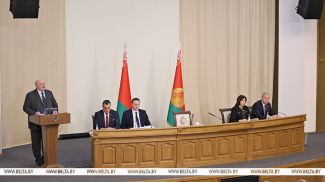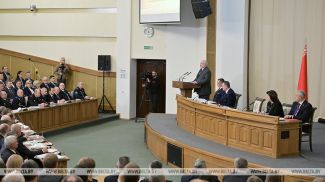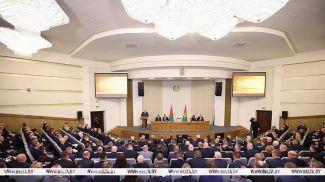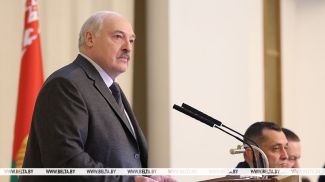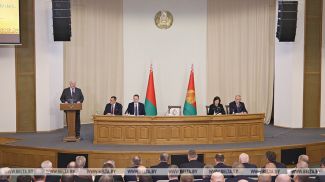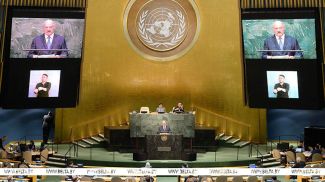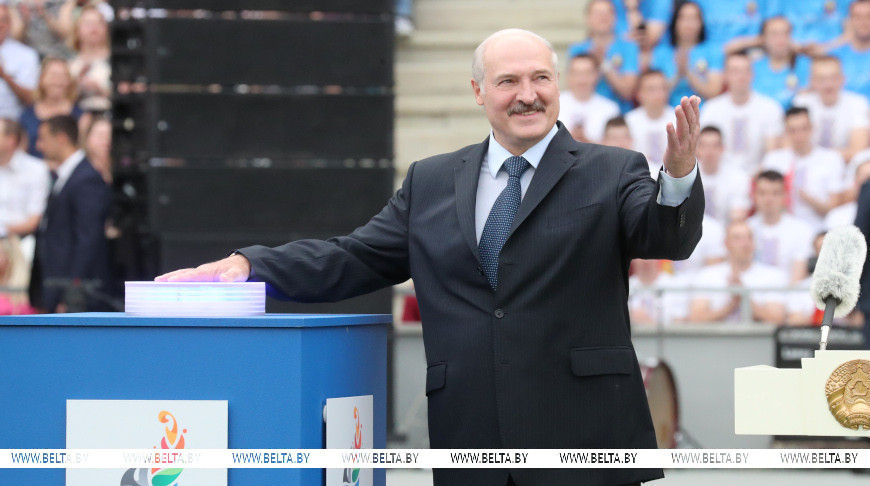


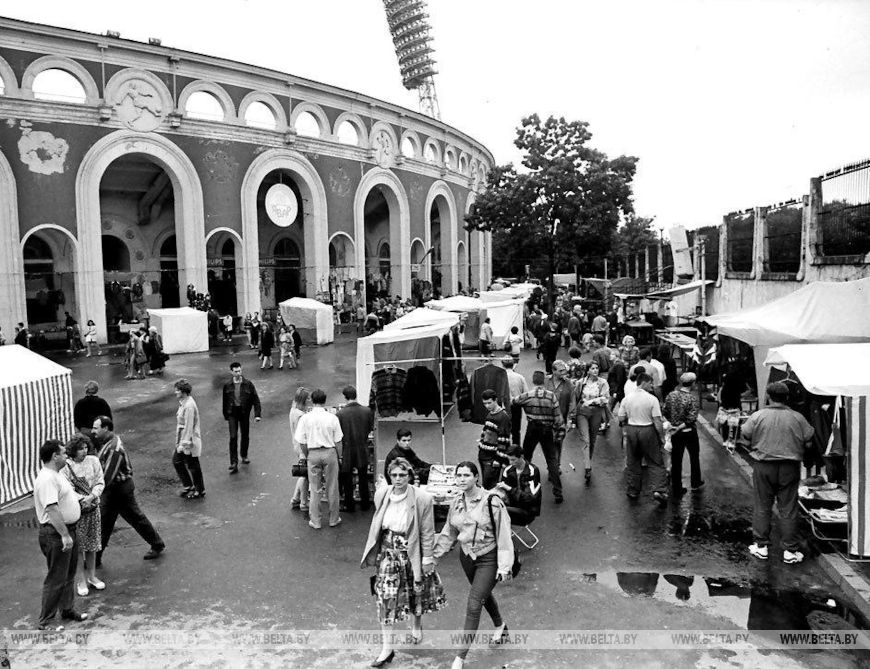 Lukashenko about the state of Dinamo: “It’s
embarrassing to go there to see matches let alone to relax”.
Lukashenko about the state of Dinamo: “It’s
embarrassing to go there to see matches let alone to relax”.
5 November 2012. Aleksandr Lukashenko convened a meeting to discuss the reconstruction of Dinamo Stadium. In his opening remarks the president talked about the development of sport infrastructure and called Dinamo Stadium one of the most important facilities the future of which should be decided.
The head of state
emphasized that the idea to overhaul the arena was discussed for a long time
but no concrete steps were taken yet. Alas, Dinamo Stadium in Minsk fell into
disrepair, President Lukashenko said at the time. Inaction aggravated the deplorable condition of Minsk’s main sports
arena.
Inaction aggravated the deplorable condition of Minsk’s main sports
arena.
At the meeting on the Dinamo Stadium reconstruction in November 2012, Aleksandr Lukashenko stated that "it’s embarrassing to go to the stadium to attend matches let alone to relax.”
The head of state criticized the protracted process as no concrete work started. "We have been talking about the need to reconstruct Dinamo Stadium for a long time. We have long been discussing this topic. We changed owners and proprietors, and finally came to the conclusion that the stadium should be turned into a national stadium. This should be a state stadium that will host major football events," Aleksandr Lukashenko noted then.
After the report by the head of the State Control
Committee, who scrutinized the issue on the instructions of the president, it
became clear that it was time for action as elementary safety hung in the
balance. "The technical condition of the stadium,
engineering communications, and the internal maintenance of the
beneath-the-stands premises pose a real threat to the safety and health of
visitors. Poor conditions for users of the premises damage the reputation of
the historical symbol of Belarusian football,"the then Chairman of the Belarusian State Control Committee Aleksandr
Yakobson said.
"The technical condition of the stadium,
engineering communications, and the internal maintenance of the
beneath-the-stands premises pose a real threat to the safety and health of
visitors. Poor conditions for users of the premises damage the reputation of
the historical symbol of Belarusian football,"the then Chairman of the Belarusian State Control Committee Aleksandr
Yakobson said.
The meeting participants cited specific facts that brought the stadium to a deplorable state and the reasons for delayed overhaul. Why did this happen? The answer to the president's question was immediately given. Those were technological violations committed during the reconstruction of the stadium in the 1990s, and, unfortunately, red tape on the part of government officials.
The costs and the historical image. What conditions the president set for Dinamo reconstruction
The meeting touched upon all issues: protracted negotiations with investors, the search for the optimal project and the reconstruction costs that reached almost €150 million. The president demanded to remove all bureaucratic obstacles and to get the project started!
"No matches on the stadium even for BATE’s rankings sake. We will find a stadium for it. We should start reconstructing the stadium immediately, not in March-April or May. There is a lot of work to dismantle the structures and remove garbage. God willing, we will be able to get it done before the spring. During this time we will complete design works, and, if we find a good company, choose the design for the stadium. Designers will have less work to do and they need to work quickly," the president noted.
Possible reconstruction projects also caused a lot of discussions. The president urged to preserve the wall around the stadium as it carries historical and cultural importance. Aleksandr Lukashenko then stressed that it was important to preserve this element as much as possible, competently integrating it into the concept of the entire project.
“We need a compact stadium of the European level, for about 40,000-45,000 seats. We do not need any frills. We are not rich enough to build something grand. We need a functional, beautiful stadium that will preserve its historical elements, which we agreed on,” the head of state said.
As for the costs, President Lukashenko suggested working out options to implement the main part of the project without foreign loans, which would save the country a lot of money. “Without wasting time, we should gradually scrap the things we do not need. Make up your mind about the project. Money should be spent rationally. If we can do it with our own money within 2.5 years and take, perhaps, a small loan for imports, then we should go this way. We will have less to pay back. Let us proceed from this,” the head of state noted.
At the meeting in November 2012 the president gave the
instruction for absolutely everyone involved in the Dinamo Stadium
reconstruction. It was simple – get down to work!
Dinamo was outdated as a market facility, too. Not only as a stadium, but also as a market
The call was heard. Work stepped up. Six months later TV showed news reports of the staff of the President
Administration participating in the reconstruction of Dinamo Stadium in Minsk
during the national subbotnik clean-up day. 
 In 2016, the head of
state participated in the reconstruction of Dinamo Stadium in Minsk during the
national subbotnik clean-up day. The president's team did a concreting work on
monolithic reinforced beamless slabs at the site. Athletes, coaches, and Minsk
administration officials worked together with Lukashenko. Having inspected progress in the stadium
reconstruction, Aleksandr Lukashenko recalled the requirement to preserve the
historic part of the stadium in the form of an arcade.
In 2016, the head of
state participated in the reconstruction of Dinamo Stadium in Minsk during the
national subbotnik clean-up day. The president's team did a concreting work on
monolithic reinforced beamless slabs at the site. Athletes, coaches, and Minsk
administration officials worked together with Lukashenko. Having inspected progress in the stadium
reconstruction, Aleksandr Lukashenko recalled the requirement to preserve the
historic part of the stadium in the form of an arcade. 
 According to Yuri
Krivodubsky, Deputy Director General for Administration and Economic Affairs of
the National Olympic Stadium Dinamo, the Belarusian president played the decisive
role in the life of Dinamo. “As Aleksandr Lukashenko came to power, he began to
streamline various sectors of the economy and sport. He knew the state of
Dinamo Stadium firsthand. He played football at the stadium, when being an MP
and president. He knew that the stadium needed at least major repair,” Yuri
Krivodubsky said.
According to Yuri
Krivodubsky, Deputy Director General for Administration and Economic Affairs of
the National Olympic Stadium Dinamo, the Belarusian president played the decisive
role in the life of Dinamo. “As Aleksandr Lukashenko came to power, he began to
streamline various sectors of the economy and sport. He knew the state of
Dinamo Stadium firsthand. He played football at the stadium, when being an MP
and president. He knew that the stadium needed at least major repair,” Yuri
Krivodubsky said.
He recalled that Dinamo was outdated as a market facility, too. Not only as a stadium, but also as a market. “The market was an unpopular place even before the reconstruction began. It experienced its heyday in the mid-1990s and early 2000s. The largest stadium in the Soviet Union, Luzhniki, was also a large market. Dinamo did not escape this fate either. The decision to set up a market there was made in the autumn of 1991. By the beginning of the reconstruction, the last entrepreneurs left the stadium without arguing. The Zhdanovichi trading house, roofed markets and malls began to spring up all over the country,” Yuri Krivodubsky said, noting that nothing was holding back the works at Dinamo.
He noted that the prokect went according to plan. Though the deadline
needed to be shifted as it was decided to get the arena the fourth, the
highest, UEFA category. The facility was promised to be commissioned in 2018. Another
promise was to make the arena a multifunctional sports and entertainment
facility fit to host athletics competitions of the highest level, football
matches, entertainment events and a full-fledged training process. 

 “In short, this is the new Dinamo Stadium. Only the historical part of
the old Dinamo Stadium remains. This is the entrance arch and the arcade
encircling the southern, northern and eastern stands. This is a brand new
stadium with new functions that are in line
with modern trends. Our stadium has been awarded the UEFA Category 4 and IAAE
Category 1. This allows it to host both football and athletics competitions of
the highest level,” the deputy director general noted.
“In short, this is the new Dinamo Stadium. Only the historical part of
the old Dinamo Stadium remains. This is the entrance arch and the arcade
encircling the southern, northern and eastern stands. This is a brand new
stadium with new functions that are in line
with modern trends. Our stadium has been awarded the UEFA Category 4 and IAAE
Category 1. This allows it to host both football and athletics competitions of
the highest level,” the deputy director general noted.
Lukashenko: I was thinking about those who played at this stadium, who tied their fate to this stadium
21 June 2018. This date went down in the history of Dinamo Stadium and the city in general. Upgraded beyond recognition, modernized using the latest technology, the sports arena was ready to host competitions! Both athletes and fans waited for this event!
Undoubtedly, the head of state who kept all the work under his personal
control also waited for this. Lukashenko attended the inauguration ceremony. He
was here that day both as president and as a devoted sports fan. 

“I am convinced that the stadium will definitely become a home for outdoor enthusiasts. From now on, Dinamo will host the largest and most interesting events,’ the president noted.
"Relying on traditions and experience, today we are opening a new
chapter in the history of the great cultural and sports facility. All
restoration and construction works here were carried out solely by Belarusian
specialists. Using advanced technologies, they carefully preserved the
historical elements, while making the stadium modern and high-tech. The stadium
is fit to host famous athletes from all over the world,” Aleksandr Lukashenko
said.  It was a spectacular
and beautiful opening ceremony! Recalling the history of the legendary stadium
that hosted the Olympics 1980 events, Aleksandr Lukashenko noted that in 2019,
exactly a year on, Dinamo Stadium would become the heart of the 2ndEuropean Games. The Belarusian president launched the countdown to the 2nd
European Games, pressing the symbolic button to the thunderous applause of the
arena.
It was a spectacular
and beautiful opening ceremony! Recalling the history of the legendary stadium
that hosted the Olympics 1980 events, Aleksandr Lukashenko noted that in 2019,
exactly a year on, Dinamo Stadium would become the heart of the 2ndEuropean Games. The Belarusian president launched the countdown to the 2nd
European Games, pressing the symbolic button to the thunderous applause of the
arena.
"It's nice that we deliver on our words." When sport was out of politics
"Sport and the Olympic movement serve high and noble goals. They are meant to unite countries and peoples, strengthen the will and character of athletes, and inspire the younger generation to dream big. So let our renovated stadium be one of the symbols of these beautiful ideals!" the president recalled the well-known principles of sport.
Belarus adheres to these principles even now. But, unfortunately, some sports functionaries from international organizations have traded sports principles for political unscrupulousness.
In 2018, Sebastian Coe, president of the International Association of
Athletics Federations, became one of the guests of the opening ceremony. In his
conversation with the Belarusian president, he praised the capabilities of the
Belarusian sports arena.  "I kept my end of
the promise. We modernized the stadium. Now we need to organize major
competitions here," the head of state said. In this regard, he recalled
the plans to hold the first international athletics match between the national
teams of Europe and the United States in Belarus in September 2019.
"I kept my end of
the promise. We modernized the stadium. Now we need to organize major
competitions here," the head of state said. In this regard, he recalled
the plans to hold the first international athletics match between the national
teams of Europe and the United States in Belarus in September 2019.
You delivered on your promise. Even more than that. Not only in terms of the stadium. Of course, we are discussing this, and this is a great help. Everything we do here is very important, because we are not only creating opportunities for athletes, but also for the younger generation, young guys who can become athletes in the future, Sebastian Coe said.
"Thank you very much. I am very pleased that we keep our word to each other,” the Belarusian president said in return.
It was quite a warm meeting then. Politics did not decide everything then. However, all the promises made by the functionary turned out empty.
“In 2019, President of the International Association of Athletics Federations Sebastian Coe attended the European Games. After 2020, his position has been very aggressive towards our country. He met with the head of state twice in 2019 and even before 2019 to discuss a Europe vs USA match. Aleksandr Lukashenko gave guarantees that we would do everything on time and at the highest level,” Yuri Krivodobsky noted.
After the 2ndEuropean Games in 2019, which were held at the highest level, Dinamo Stadium
hosted the Europe vs USA athletics match. 
“In 2019, we hosted the competitions of the 2ndEuropean Games and the athletics match between the United States and Europe, the athletes of these teams. Representatives of national Olympic committees of European countries attended the 2nd European Games, too. So did the leadership of the European Olympic Committees. In 2019, we hosted the late European Athletics President Svein Arne Hansen,” Director General of the National Olympic Stadium Dinamo Aleksandr But-Gusaim recalled those events. “During the visit, everyone praised the stadium as a world-class arena, its running tracks with the fastest surface. In general, the arena is pleasant to compete in because it has warm vibes. The history of the stadium, its legacy combined with its modern outfit create a sense of comfort for athletes. Its infrastructure is also remarkable. It is rare when the warm-up and main stadiums are located within the same complex. Often, these are different arenas. Athletes warm up in one place, then are bussed to another, to the main arena. In our case, it is all within Dinamo Stadium.
Yuri Krivodubsky, Deputy Director General of
the National Olympic Stadium Dinamo, noted that at that time politics did not
have such a significant impact on sports life and athletes from different countries
and officials of various international sports organizations gave a fair high
assessment of the stadium, noting the widest possibilities of our sports arena.
“Reviews were good, very favorable. In 2019, the heads
of national Olympic committees of European countries were here at the opening
ceremony, at athletics competitions.”  Dinamo is a place of attraction for sports
and cultural events
Dinamo is a place of attraction for sports
and cultural events
Indeed, Dinamo Stadium in Minsk is a unique structure, familiar from childhood to more than one generation of athletes and fans not only in Belarus. Risen from the ruins of the war, this historical complex is a pride of Minsk! Unlike rash political decisions that corrode the foundations of the sports movement, the renovated arena continues its glorious history. We are sure that it will be very interesting going forward!
Today, according to Aleksandr But-Gusaim,
the sports facility is becoming, as intended, a place of attraction for both
sports and cultural events. “In addition to sports events, we host auto shows.
Now we are live streaming matches of the European Football Championship. Entry
is free. After this, we plan to continue the project, which was popular last
year. These are film screenings, film picnics at Dinamo. Anyone can come, buy a
ticket and watch a movie on the reserve field or here. We host concerts,
various activities, festivals. In August we will open a children’s playground
on the upper level and a workout town for teenagers and fitness enthusiasts.
While kids will play on the playground, their parents will be able to do sport
or watch a match.This year we are planning to open a
children's entertainment room at Dinamo Stadium modeled on kids’ corners in
supermarkets when kids can enjoy themselves for an hour or two under
supervision. Indeed, we have a lot of plans. We will try to implement
everything, but the most important thing is focus on quality, which is a must
in the Year of Quality, the director general shared the plans.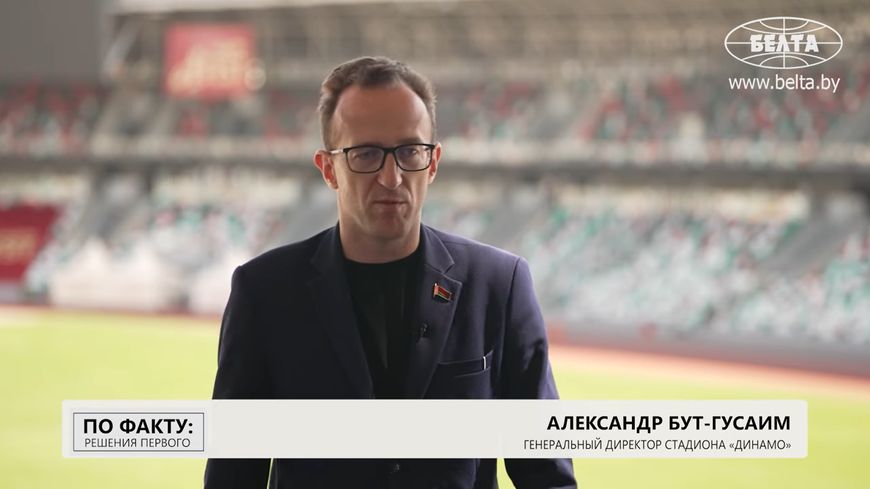 When speaking about Dinamo Stadium, Maksim
Voropai, Head of the Main Department of Sport and Tourism, Minsk City Executive
Committee, added that it hoses a lot of events of all sorts, though the focus
is on sport.
When speaking about Dinamo Stadium, Maksim
Voropai, Head of the Main Department of Sport and Tourism, Minsk City Executive
Committee, added that it hoses a lot of events of all sorts, though the focus
is on sport.
“Today Dinamo Stadium is really a unique
sports facility that hosts many sports competitions. track and field athletes
use it as a training ground. The stadium also has boxing, judo and fencing
halls, a unique shooting range where athletes train in shooting from air rifle
and pistol. We opened a department for rock climbing training because the
stadium has a unique rock-climbing wall,” Maksim Voropai said added that the
stadium hosts football competitions among the top league teams, friendly
matches between Belarusian and Russian teams, and among amateur teams. Recently
two football matches have been held here. They were watched by thousands of
spectators.






